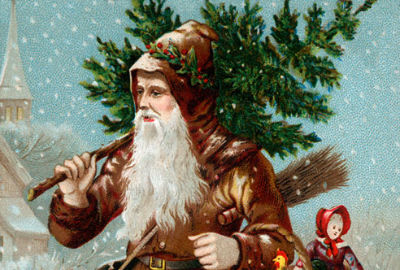About This Timeline
This timeline combines the content from other articles on Briefhistory.net into an easy to follow sequential format. It is not intended to introduce new information but to display it in a new way. The bits of information that were combined to create this timeline include the following:
As we add new content to BriefHistory.net, we will also update this timeline with new and interesting bits of trivia and place them into the proper place in the timeline.
-
Over 4000 years ago
Zagmuth and the 12 days of Christmas
Over 4000 years ago, the Mesopotamians celebrated each new year with a 12-day festival, called Zagmuth. The Mesopotamians, who believed in many gods, held this festival in support of their chief god, Marduk, because they believed that he battled the monsters of chaos at the beginning of each winter. It is from this festival that the 12 days of Christmas is believed to have originated.
-
4th Century A.D.
Bishop Nicholas of Smyrna(Saint Nicholas)
One cannot talk about the history of Christmas without mentioning Santa Claus. Bishop Nicholas of Smyrna, who lived in the 4th century A.D. in what is known today as Turkey, was a very wealthy and generous man, who especially loved children. He was known to throw gifts into the houses of poor children in order to brighten their spirits. He was later titled Saint Nicholas, and became the patron saint of children and seafarers. From his story evolved the legend of Santa Claus – the jolly man who brings gifts to children all over the world on Christmas Eve. In England he came to be known as Father Christmas, in China he is known as Dun Che Lao Ren, which means “Christmas Old Man”. Many believe that the giving of gifts originates from the deeds of Bishop Nicholas, and not the Roman tradition of giving gifts during the festival of Saturnalia. More likely, the tradition evolved from both practices.
-
1843
First Christmas Card
It is believed that British painter John Callcott Horsley designed the first Christmas card in 1843. Horsley designed the card for his friend Sir Henry Cole, who was the first director of the Victoria and Albert museum. The card showed a family celebrating Christmas, and read “A Merry Christmas and a Happy New Year to You”. The tradition caught on quickly in England, and it was not long before the first Christmas cards began showing up in the United States and other countries as well.
-
1750’s
First Candy Canes
It just wouldn’t be a modern Christmas without candy canes being strung up on every horizontal surface. They were originally designed to the first religious treat. An Indiana candy maker came up with the idea, making them white to show the purity of Christ. Then he made them in a shape which could either represent the J in Jesus or the staff used by a Sheppard. Jesus was said to be the Sheppard of his people. They were originally stained red to show the blood of Christ, but this proved more work than many who made them would go to. It wasn’t until the 1950’s, almost 200 years after they were first designed that an automated process of adding the stripes would be invented. This sealed the candy cane in our Christmas history. Today, however, almost no one can tell you of their religious beginnings.
-
1823
"A Visit from St. Nicholas"
The actual names of Santa's reindeer were first printed in a poem in 1823 in the Troy Sentinel called “A Visit from St. Nicholas.” Controversy surrounds who exactly wrote the poem, but the poem and the names of the 8 tiny reindeer remain a favorite poem that is read each Christmas.
-
1843
First Christmas Card
The very first Christmas card was created in England in 1843 and the picture on the front of the card was drawn up by John Calcott Hawsley. This card was first commissioned by Sir Henry and it was a picture that showed the poor being fed and clothed with a middle panel featuring a family enjoying the Christmas festivities. The message on this very first card said “A Merry Christmas and a Happy New Year to you”. While history states that Sir Henry did not send any further cards next year the custom continued as more and more people started to send cards at Christmas.
-
1875
First Christmas Cards in America
In 1875 a German immigrant called Louis Prang who had opened up his own Lithia graphic shop which made the first Christmas cards produced in America. From here the availability of cards for Christmas exploded in America and many different shops started selling them.
-
1939
Rudolph the Red-Nosed Reindeer
In 1939, Robert L. May, a clerk for Montgomery Ward, created a poem about a reindeer named Rudolph the Red-Nosed Reindeer. Rudolph quickly became a loved symbol of Christmas. Other reindeer were talked about over the years in poems, songs, and movies.
-
1947
Re-introduction of African-Americans to the National Leagues
1947 saw the re-introduction of African-Americans to the national leagues, and in 1951 center fielder Willie Mays rocked the world of baseball with the infamous “shot heard round the world”. Also during the 1950’s, baseball’s first television appearance skyrocketed the sport’s popularity.
-
1970s
Black Friday Begins
Black Friday is not actually very old and many people might believe, in fact it was thought that the first Black Friday was held in the 1970s. It was a day when retailers decided to mark the start of the holiday season by offering discounts to their customers. In the history of holiday shopping many stores invest in a lot of promotional dollars in order to draw customers through their doors on this day. This was a large success and resulted in the name Black Friday as most stores, thanks to their sales, were in the black in financial terms.
More From Holidays
 2021-10-07
2021-10-07
History Of Christmas
 2021-10-09
2021-10-09
5 Suprising Facts In The History Of Christmas
 2021-10-09
2021-10-09
Santa's 8 Tiny Reindeer
 2021-10-09
2021-10-09
History of Black Friday
 2021-10-09
2021-10-09
History Of The Christmas Card
 2021-10-09
2021-10-09
The Legend of Santa Claus
 2021-10-09
2021-10-09
Origin of Mrs. Claus
 2021-10-09
2021-10-09
History Of The Christmas Gift
 2021-10-09
2021-10-09